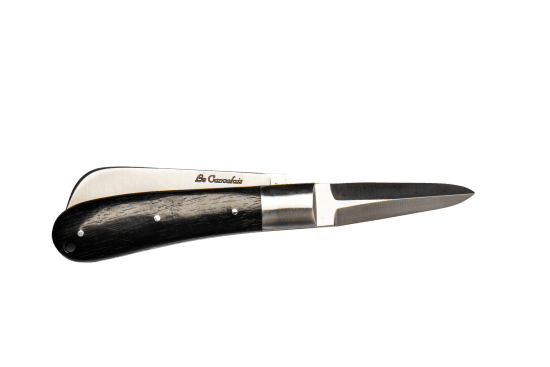Le Cancalais © - ebony wood

Ingredients: Blades in Swedish Sandwick steel (12c27) containing 0.65% carbon and 13% chromium.
Ebony wood handle.
Competition sail case.
Large open blade: 18.5 cm
Open Huitrière blade : 16,5 cm
Handle: 10 cm
Ebony wood handle.
Competition sail case.
Large open blade: 18.5 cm
Open Huitrière blade : 16,5 cm
Handle: 10 cm
A knife for sailors and travelers designed by Olivier Roellinger and manufactured in Thiers (France).
French maritime knives range from the long blades used to slice cod by terre-neuvas fishermen, to the sail-shaped Cape Horn knives pirates and privateers used to cut lines—and throats. What was missing was a model designed especially for opening and enjoying oysters.
French maritime knives range from the long blades used to slice cod by terre-neuvas fishermen, to the sail-shaped Cape Horn knives pirates and privateers used to cut lines—and throats. What was missing was a model designed especially for opening and enjoying oysters.
€120.00
Recommendations
Rinse under cold running water after using, then wipe dry before closing.
Rub the base of the blades with mineral oil from time to time to keep the hinges from sticking.
Polish the ebony, teak, or olive handle regularly with linseed oil.
Prime the blade with a sharpening steel or sharpen with an oilstone sharpener.
Rub the base of the blades with mineral oil from time to time to keep the hinges from sticking.
Polish the ebony, teak, or olive handle regularly with linseed oil.
Prime the blade with a sharpening steel or sharpen with an oilstone sharpener.
-
Origin
Made in Thiers (France)
Olivier Rœllinger's words
I am fortunate to call Cancale, a small Breton port between Saint-Malo and Mont-Saint-Michel my home.
Here, boating is akin to riding a bicycle : everyone learns how when they’re young. All sailors need a good knife, that loyal and most necessary companion on the water, whether they’re headed to sea for long journeys or simply out for the day to sail or fish.
This oyster blade is a thing of beauty in both form and function, whether you prefer to open your oysters along the side edge or by the back hinge. The blade works well on both Belon and Pacific oysters while a clever lock system ensures maximum safety. It took several knife prototypes to find the right model.
After opening an oyster with a deft movement that epitomizes life by the sea, use the knife to slather a slice of bread with salted butter. The creamy spread will pearl beneath the caress of a blade designed to nourish but never wound.
Here, boating is akin to riding a bicycle : everyone learns how when they’re young. All sailors need a good knife, that loyal and most necessary companion on the water, whether they’re headed to sea for long journeys or simply out for the day to sail or fish.
This oyster blade is a thing of beauty in both form and function, whether you prefer to open your oysters along the side edge or by the back hinge. The blade works well on both Belon and Pacific oysters while a clever lock system ensures maximum safety. It took several knife prototypes to find the right model.
After opening an oyster with a deft movement that epitomizes life by the sea, use the knife to slather a slice of bread with salted butter. The creamy spread will pearl beneath the caress of a blade designed to nourish but never wound.
Story
The knife’s shape is similar to London pocket knives that 18th century seafarers kept in their pockets.
The blades have rounded ‘sheep’s foot’ tips because, according to legend, boarding a boat with a pointed blade was strictly forbidden in order to prevent deadly fights among the crew.
The knife’s silhouette resembles the shape of a sperm whale or the swell of a wave. When closed, the knife is reminiscent of a ship’s hull and fits snugly in the palm of your hand.
London knives originally included a small splicing blade, which we’ve chosen to replace with an oyster knife.
The blades have rounded ‘sheep’s foot’ tips because, according to legend, boarding a boat with a pointed blade was strictly forbidden in order to prevent deadly fights among the crew.
The knife’s silhouette resembles the shape of a sperm whale or the swell of a wave. When closed, the knife is reminiscent of a ship’s hull and fits snugly in the palm of your hand.
London knives originally included a small splicing blade, which we’ve chosen to replace with an oyster knife.